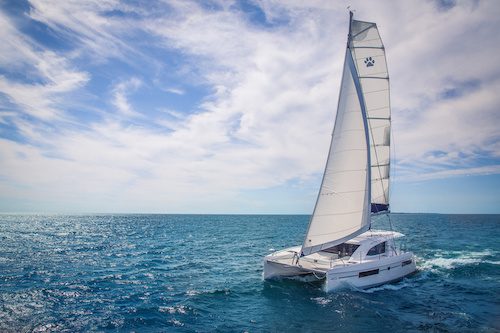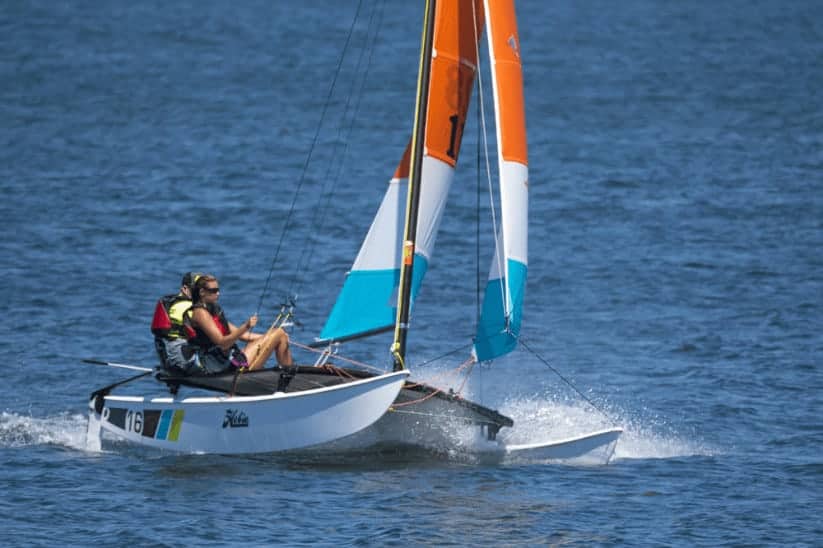When you are learning to sail, many sailors want to know if it is possible to sail a boat that does not have a keel.
Some sailboats do not have a keel. The most popular types of boats to sail without a keel are catamarans and dinghies. Neither the catamaran nor the dinghy has a keel. Most other sailboats have a keel that holds the ballast, which helps keep the boat upright and prevents tipping over or capsizing.
Table of Contents
- Basic Types Of Sailboats Without A Keel
- What Is A Keel?
- Frequently Asked Questions
- Related Questions
Basic Types Of Sailboats Without A Keel
Some sailboats do not have a keel. Some more popular sailboats that do not use a keel include Catamarans and Dinghies. Here is the information on each of these
Catamaran Sailboats Do Not Have A Keel

A Catamaran sailboat is considered a multi-hulled watercraft with two parallel hulls of equal size. It is a very stable sailboat that gets its stability from the wide beams rather than from a ballasted keel as with a monohull boat or what most people think of as a sailboat.
Catamarans were invented by the Austronesian people, who used Catamaran-style boats to sail across the ocean to expand their reach in the Indian and Pacific Oceans. The word catamaran comes from Tami, ” logs bound together.”
Catamarans do not need a keel as they sit or almost glide on top of the water. If you have ever sailed a catamaran as I have, you can feel how the boat will glide on top of the water, which is very different than the standard keel sailing vessel.
Catamarans can range in size from enormous vessels to smaller vessels. There are even catamarans that are navy ships or car ferries.
Catamarans continue to be popular cruising and sailing vessel. Some of the larger catamarans have cabins and sleeping areas. Many of the smaller catamarans are used for racing or sailing for enjoyment.
Many smaller catamarans known by the brand name Hobie Cat can capsize. I have sailed on many smaller catamarans where I either fell off the boat or the boat completely capsized or tipped over. To sail these small catamarans, you must bring the boat upright again. Bringing a boat upright in the ocean can sometimes be challenging.
Dinghy Sailboats Do Not Have A Keel

Another type of popular sailboat would be a small sailboat smaller than 20’ called a Dinghy. The Dinghy sailboat is a popular boat for many people to learn to sail on. I learned to sail on a Dinghy with a sailing course I took in the Philippines.
A dinghy has no keel nor a ballast. To help the boat resist sideways movement, it has a centerboard or daggerboard that can usually be raised or lowered as needed.
Sailing a dinghy is a popular choice if someone is sailing in an area with a lower sea or lake bed. The fact you can take the centerboard up and down can allow you to sail in shallow water.
A dinghy can capsize, so anyone who learns to sail on a sailboat must also know the steps you must take when the boat capsizes.
A dinghy does not have a ballast, but many sailors will use what is called a “live ballast,” where the crew will sit out on the edge of the boat to try to counter the effects of the wind and keep the boat in balance.
What Is A Keel?
To understand if you can sail without a keel is good to know what a keel is. The sailboat’s keel is the flat blade sticking down into the water from a sailboat’s bottom.
The keel has two basic functions:
- A keel prevents the boat from being blown sideways by the wind.
- The keel holds the ballast that keeps the boat right-side up.
The keel on a sailboat can come in many different styles and even materials. The material of the keel is usually what the sailboat bottom is made of, whether wood, metal, or fiberglass.
As a boat with a built-down keel can be slow, most modern sailboats will have a “fin” kind of keel. This kind of keel ensures that the ship glides faster through the water.
Keel Boats And Capsizing
One of the things that many beginning sailors want to know is if the boat they are sailing on will capsize. I know it can be scary to be out there in the high winds with a boat heeling over and to feel like you are going to capsize and fall in the water; I have been there and know how it feels.
A keelboat will not capsize in the strong winds. It may feel like it is as the boat is heeling way over, but the ballast in the keel is designed to keep it from capsizing.
That is one of the advantages of a sailing boat with a keel: it will not capsize even if you are in strong winds and the boat is heeling over. I may feel you’re ready to capsize any moment, but it is almost impossible to capsize a keelboat.
If you want to sail a boat with no keel, then a catamaran or a dinghy should be your choice. On the other hand, if you are nervous about capsizing in a boat, you may want to sail a boat with a keel like the Ensign keel boat that I sail.
At A Bus On A Dusty Road, we talk about travel, life, sailing, and ex-pat living. We are all about “Living Life As A Global Citizen.” We explore social, cultural, and economic issues and travel.
We would love to have you be part of our community. Sign up for our newsletter to keep up-to-date by clicking here. If you have any questions, you can contact me, Anita, by clicking here.
Listen to our Podcast called Dusty Roads. You can find it on all major podcast platforms. Try out listening to one of our podcasts by clicking here.
Subscribe to our A Bus On A Dusty Road YouTube Channel with great videos and information by clicking here.
Frequently Asked Questions
Can you sail a boat without a keel?
Yes, you can sail a boat without a keel. Many types of sailboats, such as catamarans and dinghies, do not have keels and are designed to be sailed effectively without them.
What is the purpose of a keel on a sailboat?
A keel on a sailboat serves multiple purposes, including providing stability by counteracting the force of the wind on the sails, preventing the boat from capsizing, and helping to maintain the boat’s course.
How do catamarans sail without a keel?
Catamarans use their wide, stable hulls to provide the necessary stability that a keel would typically offer. The two hulls create a wide base that resists tipping, allowing catamarans to sail without a traditional keel.
Can a dinghy sail without a keel?
Yes, dinghies are designed to sail without a keel. Dinghies are smaller, lightweight boats that rely on their hull shape, crew weight distribution, and daggerboards (or centerboards) for stability and control.
Why do some sailboats not have a keel?
Some sailboats are designed without keels to enhance maneuverability, allow for shallow-water navigation, and accommodate specific sailing conditions or preferences, such as racing or recreational sailing in shallow areas.
Are there disadvantages to sailing without a keel?
Sailing without a keel can make a boat more susceptible to drifting sideways in strong winds or currents, and it may require more active crew participation to maintain stability and prevent capsizing.
Can you sail in open waters without a keel?
While it’s possible to sail in open waters without a keel, it’s generally more challenging and less stable compared to sailing with a keel-equipped boat. Catamarans and dinghies used for open-water sailing often have specialized designs to compensate for the lack of a keel.
How do you prevent a sailboat without a keel from capsizing?
Sailboats without keels, such as catamarans and dinghies, rely on other means of stability, such as crew weight distribution and hull design. Proper sail trim, balance, and crew positioning are crucial to prevent capsizing.
Can you race sailboats without a keel?
Yes, you can race sailboats without a keel. In fact, many competitive racing classes involve catamarans and dinghies that are specifically designed for racing without keels.
Related Questions
What Is The Function Of A Sailboat Keel?
The keel is the part of the boat that is down into the water as a blade or ridge. The part of the boat keeps the ship upright and from tipping or blowing sideways. It is also a critical part of the boat that helps steer and control the sailboat.
By clicking here, you can discover What Is The Function Of A Sailboat Keel?.
How Much Wind Is Too Much For A Beginner Sailor?
For a beginner sailor, the wind is usually recommended to be under 10 knots. Those who are more experienced or with a larger boat can consider going up to 12 knots of wind. A knot is not the same as miles per hour or kilometers per hour but is faster than these measurements.
By clicking here, you can discover How Much Wind Is Too Much For A Beginner Sailor?
No Experience Sailing, 6 Tips To Get Started
If you are going to take up sailing, you first must get on a boat and find out if sailing is suitable. The best sailors can handle their boats in all kinds and types of weather. Find a class that you can join and get certified. Sailing requires knowledge and skill. Find yourself a sailing community that you can be part of.
By clicking here, you can discover No Experience Sailing, 6 Tips To Get Started.


